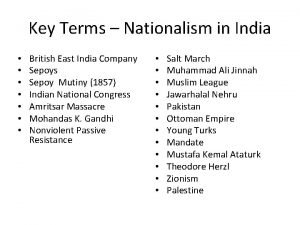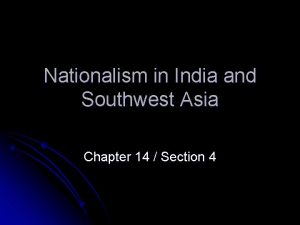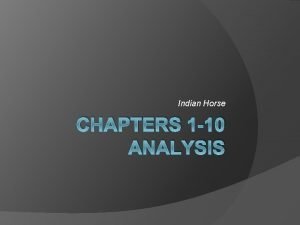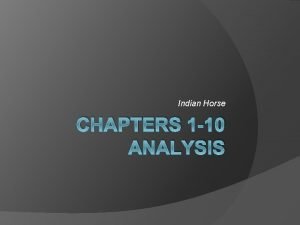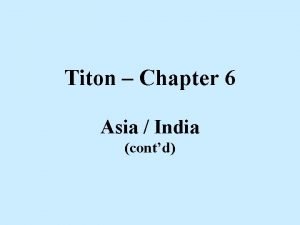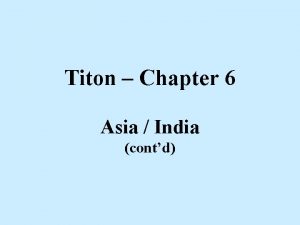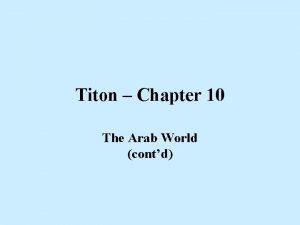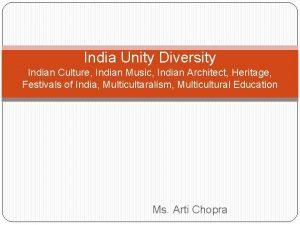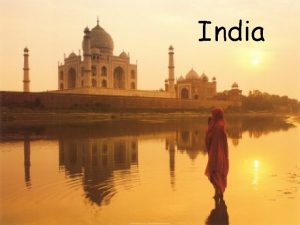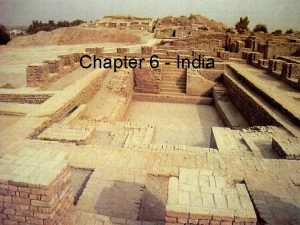Titon Chapter 6 Asia India contd Some Indian



















![Raga (cont’d) • SA = home (Vadi = “King”) [drone] • PA (5 th) Raga (cont’d) • SA = home (Vadi = “King”) [drone] • PA (5 th)](https://slidetodoc.com/presentation_image/bba0beff972181e08613a4cf81c3c1ba/image-20.jpg)

- Slides: 21

Titon – Chapter 6 Asia / India (cont’d)

Some Indian Musical Instruments • “Classical” Instruments - long history & association w/ India • Music treated as “art” experience - “Museum” culture - for edification, appreciation & enjoyment

Sitar (playing position) Amazing Sitar Player

Vina (playing position) Ex. Veena performance

Tabla (playing position) Ex. Solo Tabla

Mridangam (playing position) Ex. Solo Mridangam

Pakhavaj (North Indian) Ex. Solo Pakhavaj

Sarod (playing position) Ex. Sarod Solo

Tampura Ex. Kaushiki Chakraborty explains the Tanpura Ex. "Shruti Box"

Santoor Ex. Santoor solo

Bansuri Ex. Bansuri Solo

Harmonium Ex. Harmonium

Jaltarang Ex. Jaltarang

Indian “Classical” Music • Venue is a Concert Hall / Recital (space dedicated to performance of this music) • Formal split between audience and performers • “Ritualized” behaviors (expected of both audiences and performers) • Music treated as “art” experience (no practical use, but for edification, appreciation & enjoyment)

Some Concert Performances • You. Tube - Ravi Shankar on the Dick Cavett Show (4: 46 - complete) • Ustad Shahid Parvez sitar - raag charukeshi (22: 46) • The Two Masters - Ustad Shahid Parvez Khan (sitar) and Ustad Zakir Hussain (tabla) live (4: 53 - excerpt) • Srivani Yalla - Veena, P. S. Kumar -Mridangam, B. N. Purushotham – Kanjira (18: 32) • Masters together Amjad Ali Khan and Zakir Hussain (1: 40: 35; start c. 15: 00 – end 31: 30) (Sarod and tabla)

Roles of the Performers • Veena (south) or Sitar (north) – leader/soloist - melodic • Tambura – drone (primary pitches) [“Shruti” layer] • Tabla (north) or Mridangam (south) – rhythm and secondary soloist • Other secondary soloists or accompanists (Sarod, etc. ) may be added

Indian Classical Performance • Improvisation (not pre-composed) • Pitch – based on Raga (scales, but more) • Rhythm – based on Tala (meters, but more) [not covered today] • Process of “unfolding” the Raga - movement from low to high - rhythmic movement from slow to fast

Indian approach to Pitch • • Emphasis on the melodic (single notes in time) Asthagi – emphasis on “home” Antara – moving upward Abhog – “home” again Octave divides into 22 intervals (West uses 12) Generally 7 pitches/ notes (“swara”) used Sa – Ri – Ga – Ma – Pa – Da – Ni – (Sa’)

RAGA • Like a (western) scale, but…. much MORE • “Raga” = “color, ” “dye, ” “tinge” - “that which colors the mind” (TEXT, p. 312) - Affect on the listener • Not just pitches/notes, but HOW one moves through them • May ascend and descend in different ways • May include specific melodic patterns and ornamentation • Usually 5 -7 notes, ordered hierarchically
![Raga contd SA home Vadi King drone PA 5 th Raga (cont’d) • SA = home (Vadi = “King”) [drone] • PA (5 th)](https://slidetodoc.com/presentation_image/bba0beff972181e08613a4cf81c3c1ba/image-20.jpg)
Raga (cont’d) • SA = home (Vadi = “King”) [drone] • PA (5 th) or MA (4 th) = second level (Samvadi = “Minister”)[drone] • Anuvadi Swaras = third level (“Servants” – define the raga) • Vivadi Swaras = foreign notes (“Enemies” – not to be used)

Classification of Ragas • Over 120, 000 ragas (claimed) • Better described as a few hundred families - “Thaats” – Mother ragas • Most performers know only a few dozen • Associated and controlled by externals - season of year - time of day - mood evoked (love, anger, sadness, fear, disgust, wonder, heroism, humor, religious devotion, [peace]) • List of ragas in Indian classical music (Wikipedia) - only some of many….
 Address contd
Address contd Chapter 15 india and the indian ocean basin notes
Chapter 15 india and the indian ocean basin notes Chapter 15 india and the indian ocean basin
Chapter 15 india and the indian ocean basin Physical features in the middle east
Physical features in the middle east Inlet of indian ocean between africa and asia
Inlet of indian ocean between africa and asia Indian soldiers hired by the british east india company
Indian soldiers hired by the british east india company Indian soldiers hired by the british east india company
Indian soldiers hired by the british east india company Is india southeast asia
Is india southeast asia Nationalism in india and southwest asia
Nationalism in india and southwest asia What continent is india located on
What continent is india located on Nationalism in india and southwest asia
Nationalism in india and southwest asia Nationalism in india and southwest asia
Nationalism in india and southwest asia Sometimes you win some
Sometimes you win some They say sometimes you win some
They say sometimes you win some Cake countable or uncountable
Cake countable or uncountable Contact forces
Contact forces Some say the world will end in fire some say in ice
Some say the world will end in fire some say in ice Some say the world will end in fire some say in ice
Some say the world will end in fire some say in ice Some trust in horses
Some trust in horses What happened to saul's parents in indian horse
What happened to saul's parents in indian horse What does zhaunagush mean
What does zhaunagush mean Colonies in southeast asia 1895
Colonies in southeast asia 1895





